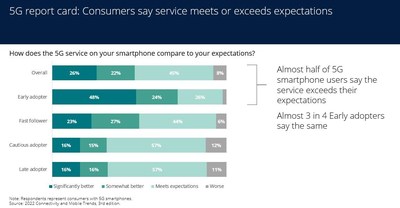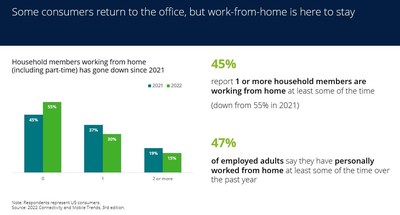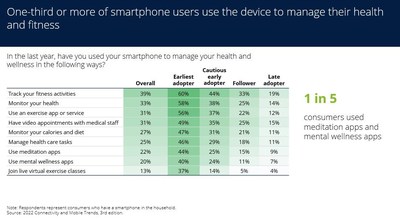Consumers Benefit From Virtual Experiences, but Need Help Managing Screen Time, Security and Tech Overload
Deloitte's "2022 Connectivity and Mobile Trends Survey" (third edition) illustrates the ways people are using connected devices and technology to improve and enhance their lives while fine-tuning the balance between virtual and physical activities
NEW YORK, Aug. 3, 2022 /PRNewswire/ --
Key takeaways
- In 2022, U.S. households remain filled with technology devices, however, the numbers of entertainment and smart home devices have dipped slightly. On average, U.S. households now have a total of 22 connected devices, down from 25 in 2021.
- Remote experiences endure even as pandemic effects ease with 45% of surveyed consumers saying one or more household members were working from home at least some of the time (down from 55% in 2021), and 23% reporting one or more household members were attending school from home at least some of the time (down from 43% in 2021).
- Virtual health care appointments remain popular, with 49% of surveyed consumers saying they've attended at least one virtual medical appointment as a patient in the past year.
- More than 6 in 10 students who attended virtual school-from-home over the past year reported their family and classmate/teacher relationships and well-being stayed the same or improved.
- More than half of those surveyed are worried about the security vulnerability of their smartphones (54%) and smart home devices (52%); 40% of users are concerned about data security on their smartwatches and fitness trackers.
- Twenty-four percent of consumers say they're overwhelmed by the devices and subscriptions they need to manage, down from 32% last year. For smart home technology, 27% of users reported these devices add too much complexity to their lives.
Why this matters
Last year, the pandemic created a "societal beta test" that brought more activities and responsibilities into the home, forcing consumers into a heavily virtual world of work, school, health care and even exercise. They added new devices, upgraded networks, and adapted quickly — even if it was sometimes overwhelming. The third edition of Deloitte's "2022 Connectivity and Mobile Trends" (CMT), an online survey of 2,005 U.S. consumers conducted in the first quarter of 2022, illustrates how consumers have since adapted to and even embraced virtual approaches and gained experience managing their digital lives.
Consumers look to "master their digital worlds"
This year, fewer people are working and learning from home, leaving some homes less crowded and reducing pressure on people, devices and networks. Consumers are striking a balance between the virtual and the physical; they're optimizing the devices they use and choosing to move forward with the virtual experiences they like best.
- Over the past year, 15% of consumers with home internet upgraded their home internet services to achieve higher speeds and 44% purchased "signal boosters" like Wi-Fi extenders and mesh network equipment to increase coverage throughout the house. A vast majority of these (87%) reported that their new equipment improved Wi-Fi performance.
- Among those who use smart home devices, 68% say the technology helps them feel safer. Among those with a smart thermostat, 69% say their device helps reduce their energy costs.
Consumers appreciate 5G, but many still seek apps and experiences specially designed for 5G
For consumers who are considering their next smartphone purchase, 5G ranks as the third most-important feature, behind battery life and data storage. 5G is the second-most important motivator for the 24% of respondents who are likely to switch mobile providers in the next year (behind "better value for the money").
- Sixty-eight percent of respondents with smartphones less than a year-old report they have 5G capability (up from 56% of respondents in 2021).
- Forty-eight percent of 5G smartphone users say the service exceeds their expectations, and another 45% say it meets their expectations.
- However, 73% of 5G smartphone users want a better understanding of what new things they can do with 5G, and 30% are disappointed by a perceived lack of innovative apps and services leveraging 5G.
Key quote
"Despite challenges brought on by the pandemic, it also proved to be a unique opportunity for many of us to dive deeper into the digital tools we were already using and accelerate how we apply them. What we've gleaned from this year's Connectivity and Mobile Trends survey is that consumers are gaining mastery over their digital lives — they are more intentional about which activities they want to take part in virtually and deciding those that are better suited for being there in-person. Our survey also found that some of the virtual and digital necessities people experienced actually had positive impacts on family, education, and health and fitness, juxtaposed against the need for stronger security and data privacy, which will ultimately create additional demand for technology companies."
- Paul Silverglate, vice chair, Deloitte LLP and U.S. technology sector leader
Work-from-home has decreased but remains an important component of today's work life
In 2022, remote work decreased but remains significant. Forty-five percent of surveyed consumers said one or more household members were working from home at least some of the time, down from 55% in 2021, and 47% of employed adults reported they have worked from home personally at least some of the time over the past year. Those with remote working experiences strongly prefer to have virtual or hybrid options for the future.
Ninety-nine percent of those who have been working from home during the past year said they appreciated aspects of the experience. The benefits they valued most were the lack of commute, enhanced comfort, reduced chance of illness, better focus and improved family connections.
- More than 8 in 10 remote workers say their family relationships, professional relationships, and physical and mental well-being have improved or remained the same.
- Seventy-six percent of employed adults who worked from home during the past year prefer virtual or hybrid options for the future, while only 21% want to work mostly or completely in-person.
Perspectives on virtual learning differ with age and experience
Educating from home has decreased more substantially than remote work, but 23% of consumers reported one or more household members were still attending school from home at least some of the time (down from 43% in 2021). Ninety-seven percent of remote learners and parents of remote learners said they appreciated some elements of remote learning. The top benefits are similar to those working from home: increased comfort, reduced chance of illness, lack of commute, better focus, and stronger family ties.
Fifty-one percent of these remote learners felt that the experience improved their family relationships, and more than 7 in 10 said their emotional and physical well-being and relationships with teachers either improved or stayed the same. Their biggest area of concern was relationships with classmates, with 36% saying those relationships had suffered.
Among those surveyed, perspectives on virtual learning differ with age and experience. Fifty-four percent of students 14-17 said they would like to be mostly or completely in-person when the pandemic eases; 46% would like to have virtual or hybrid options. For adult learners, 18 years of age and older, 40% would like to be mostly or completely in-person, and 60% want virtual or hybrid options. We saw a stronger affinity for virtual learning among teens and adults who experienced it over the past year: 41% prefer mostly or completely virtual, another 29% want an even hybrid mix of virtual and in-person, and 28% want to be mostly or fully in-person (teens and adults with remote experience answered similarly).
Virtual health care is here to stay; smartphones and wearables boost fitness
Forty-nine percent of consumers said they attended at least one virtual medical appointment as a patient in the past year — with millennials leading the trend at 59%. Ninety-two percent of consumers now say they're very or somewhat satisfied with their virtual medical experiences — up 10 points from 2021. Respondents said that convenience and ease of scheduling are top benefits of virtual health care, however, consumers did cite ongoing challenges including the lack of face-to-face connection, difficulties collecting vital signs and technology issues, such as issues with connectivity. In addition, smartwatches and fitness trackers continue to grow in popularity with 41% of respondents reporting they personally own a smartwatch or fitness tracker — up two points from 2021 — and 6 in 10 have them in their households.
- At least a third of smartphone users are monitoring their health and fitness with their phones, and 1 in 5 use meditation or mental wellness apps.
- Nine in 10 consumers who own these devices use them to track fitness and monitor health metrics.
- The most common uses are to count daily steps, check pulse rate, count calories/nutrition, monitor heart health and track sleep. More than a third of users get reminders or badges to motivate them to exercise.
Key quote
"Seemingly overnight, the pandemic created a seismic shift in how we use digital tools and technology. While not always seamless, our survey shows that this new, digital-first lifestyle has become more normalized and standardized and is having a positive impact on consumers. However, tech fatigue and frustration with the complexity of managing devices remains a real challenge for users. We're seeing that consumers want to become more deliberate with their digital usage. Tech and media companies should heed this pain point and make controls and limitations easier to manage."
- Jana Arbanas, vice chair, Deloitte LLP and U.S. telecom, media and entertainment sector leader
Alleviating consumer concerns
While consumers feel their devices and virtual experiences are having a positive effect on their lives, there are still some concerns around privacy, controlling screen time, and dealing with tech complexity.
- Security and privacy are top of mind - Fifty percent of respondents are worried about security breaches (e.g., hackers stealing personal data) and 41% are concerned about being spied on through their devices. Nearly half (49%) of smart home users are concerned about hackers "taking over" their smart devices (for instance, changing thermostat settings).
- Parents and children both worry about screen time overload - Both parents and children feel the struggle to limit kids' screen time — but children feel the issue more. While 5 in 10 parents struggle to keep their kids' screen time within comfortable limits, 6 in 10 teens, aged 14-17, admitted struggling with their own screen time.
- Tech fatigue remains an issue - One-quarter (24%) of consumers say they are overwhelmed by the devices and subscriptions they need to manage — down from 32% last year. For smart home technology, 27% of users reported that these devices add too much complexity to their lives.
For additional details on the survey, visit here. Connect with us on: @DeloitteTMT; @PaulSilverglate; @JanaArbanas.
About Deloitte
Deloitte provides industry-leading audit, consulting, tax and advisory services to many of the world's most admired brands, including nearly 90% of the Fortune 500® and more than 7,000 private companies. Our people come together for the greater good and work across the industry sectors that drive and shape today's marketplace — delivering measurable and lasting results that help reinforce public trust in our capital markets, inspire clients to see challenges as opportunities to transform and thrive, and help lead the way toward a stronger economy and a healthier society. Deloitte is proud to be part of the largest global professional services network serving our clients in the markets that are most important to them. Building on more than 175 years of service, our network of member firms spans more than 150 countries and territories. Learn how Deloitte's more than 345,000 people worldwide connect for impact at www.deloitte.com.
Deloitte refers to one or more of Deloitte Touche Tohmatsu Limited, a UK private company limited by guarantee ("DTTL"), its network of member firms, and their related entities. DTTL and each of its member firms are legally separate and independent entities. DTTL (also referred to as "Deloitte Global") does not provide services to clients. In the United States, Deloitte refers to one or more of the US member firms of DTTL, their related entities that operate using the "Deloitte" name in the United States and their respective affiliates. Certain services may not be available to attest clients under the rules and regulations of public accounting. Please see www.deloitte.com/about to learn more about our global network of member firms.
![]() View original content to download multimedia:https://www.prnewswire.com/news-releases/consumers-benefit-from-virtual-experiences-but-need-help-managing-screen-time-security-and-tech-overload-301598721.html
View original content to download multimedia:https://www.prnewswire.com/news-releases/consumers-benefit-from-virtual-experiences-but-need-help-managing-screen-time-security-and-tech-overload-301598721.html
SOURCE Deloitte


